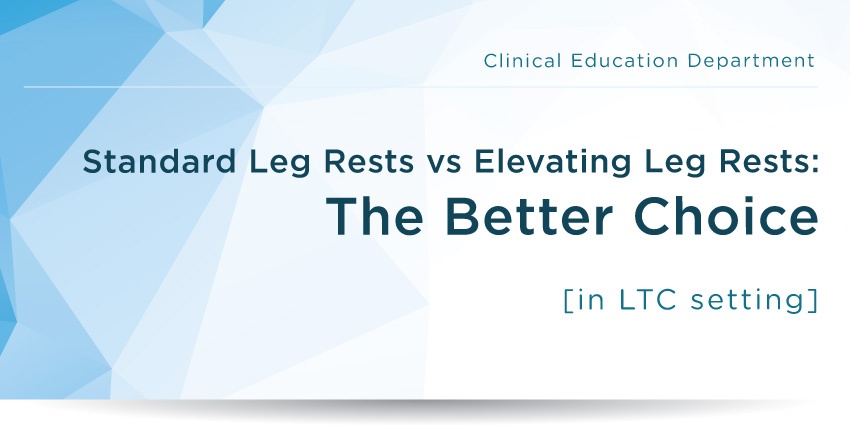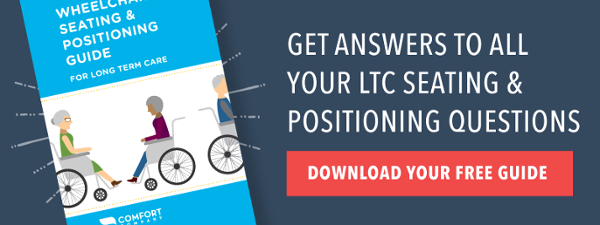As we age, many changes occur to our muscles, bones, and joints. Our body becomes very rigid –like an ironing board – instead of moving in compartmentalized units. This can be due to the following changes:
Muscles
- Muscle fibers reduce in quantity and shrink in size
- Lost muscle tissue is regenerated more slowly, replaced with tougher, more fibrous tissue
- Muscles shorten and become more rigid
Joints
- Cartilage decreases between bones at the joint and allows for more bone-on-bone contact
- Joints lose synovial fluid, becoming stiffer and less flexible
- Ligaments shorten and lose flexibility
Bones
- Vertebrae lose fluid and disk space between vertebrae become thinner, causing our trunk to shorten
- Loss of minerals in the vertebrae cause compression and curvature of the spine
- Loss of calcium and minerals make our bones more brittle
When we are positioning a resident, we do not want to do anything to the wheelchair that will increase unwanted pressure or stress on the already compromised muscles and skeleton of our elderly resident.
In the LTC setting, we purchase mostly K0001-K0004 manual wheelchairs that don’t provide a whole lot of adjustability (with the exception of the K0004). The sales representative always asks if we would like standard leg rests or an elevating leg rests (ELRs). Most of us are under the impression that ELRs are the better option. Facilities push them on us because they “help edema,” “keep the hips back in the chair,” “decrease pressure on the pelvis,” and “assist with LE alignment.” So ELRs are the best option, right?
The Answer to that question is: NO! I am here to explain to you why this assumption is oftentimes incorrect.
Here are common myths about ELRs that require ABSOLUTE CLARIFICATION to help you understand why standard leg rests are more often the better option to avoid that unwanted pressure or stress on our resident’s already compromised muscles and skeleton.
ELEVATING LEG RESTS
Decrease Edema: WRONG!
- Contrary to popular belief ELRs acting alone do nothing to decrease edema.
- In order to decrease edema, the legs must be above heart level, and no leg rest can achieve that.
- Refer to last week’s blog for further detail.
Keep hips back in chair: WRONG!
- ELRs do just the opposite!
- When we elevate the legs, we pull on the already tightened hamstrings of the resident.
- The shortened hamstrings cause a greater pull on the pelvis, bringing the pelvis into a posterior pelvic tilt.
- The posterior pelvic tilt makes the pelvis slide forward resulting in sacral sitting.
- The resident begins to slide forward out of the chair, the exact opposite of keeping the hips back in the chair!
Decrease pressure on pelvis: WRONG!
- ELRs actually position the pelvis in a posterior pelvic tilt.
- The forced posterior pelvic tilt increases pressure on the bony prominences of the ITs, sacrum and coccyx increasing the risk of wound development in those areas.
- Elevating the leg rests promotes knee flexion, leading to decreased femoral contact, shifting the pressure back onto the ITs and sacrum/coccyx.
ELRs help with LE alignment: WRONG!
- ELRs prevent full femoral contact with the seat surface.
- Since less of the leg is making contact with the seat surface, it is easier for the leg to internally/externally rotate or abduct/adduct.
- Legs then fall off legrests more easily.
- Windswept deformity is more prevalent.
- ELRs promote flexion of knees, hips, and ankles, increasing the risk of contracture at those joints.
AVOID THE USE OF ELRs as much as possible for optimal positioning in a K0001-K0004 manual wheelchair. Our compromised muscles and skeleton cannot withstand the less than desirable position of the pelvis and LEs that ELRs create especially when elevated at higher settings. Hopefully I have helped you to see why ELRS are NOT the best choice for our nursing home resident.

Ana Endsjo, MOTR/L, CLT
Clinical Education Manager LTC Division
Ana Endsjo has worked as an occupational therapist since 2001 in a variety of treatment settings. She has mainly worked with the geriatric population, dedicated to the betterment of the treatment of the elderly in LTC centers. Her focus has been on seating and positioning and contracture management of the nursing home resident. With this experience, her hope is to guide other therapists, rehab directors, nurses, and administrators through educational guides, blogs, webinars, and live courses in her role as Clinical Education Manager for the long term care division.

